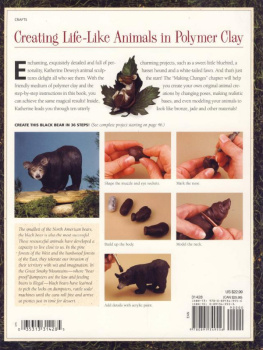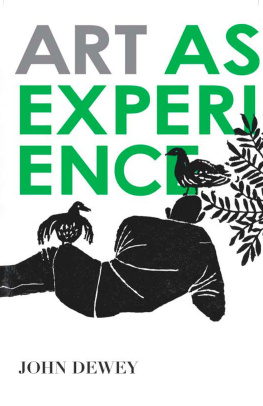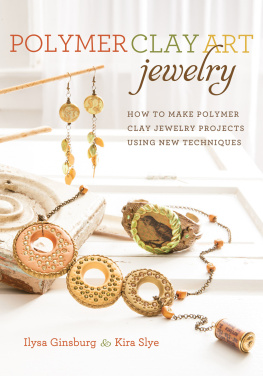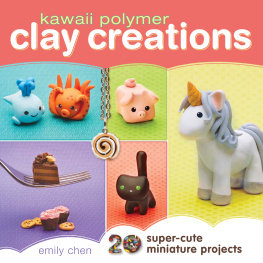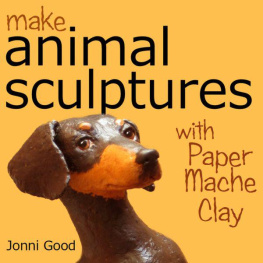Creating
________________________
L ife-Like Animals
in Polymer Clay
Katherine Dewey

www.artistsnetwork.com
Dedicaition
To the Kilroy man, my first and best teacher,
and others like him, artists and teachers
who share their knowledge for the love of their craft.
Acknowledgments
To Maureen Carlson, who suggested I could; Greg Albert, who asked if I would; and Jennifer Long, who showed me how I should write this book: Thank you.
Thank you to Barbara McGuire of Accent Imports for providing samples of FIMO Soft and FIMO Stone.
Thank you to the people at Polyform Products for their extreme generosity.
Special thanks to photographer James Clay Walls of All Image Studios, San Marcos, Texas. He is a wizard with light.
Creating Life-Like Animals in Polymer Clay. Copyright 2000 by Katherine Dewey. Manufactured in China. All rights reserved. The patterns and drawings in this book are for the personal use of the crafter. By permission of the author and publisher, they may be either hand-traced or photocopied to make single copies, but under no circumstances may they be resold or republished. It is permissible for the purchaser to create the designs contained herein and sell them at fairs, bazaars and craft shows. No other part of this book may be reproduced in any form or by any electronic or mechanical means including information storage and retrieval systems without permission in writing from the publisher, except by a reviewer, who may quote brief passages in a review. Published by North Light Books, an imprint of F+W Publications, Inc., 4700 East Galbraith Road, Cincinnati, Ohio 45236. (800) 289-0963. First edition.
Other fine North Light Books are available from your local bookstore, art supply store or direct from the publisher.
11 10 11 10 9
Library of Congress Cataloging-in-Publication Data
Dewey, Katherine
Creating life-like animals in polymer clay / Katherine Dewey.
p. cm.
ISBN-13: 978-0-89134-955-6 (alk. paper)
ISBN-10: 0-89134-955-3 (alk. paper)
1. Polymer clay craft. 2. Animal sculpture. I. Title.
TT297.D48 2000
731.42-dc21
99-046378
CIP
Editor: Jennifer Long
Production Coordinator: Kristen Heller
Cover design: Brian Roeth
Interior design: Wendy Dunning
Photography: James Clay Walls, All Image Studios, San Marcos, Texas

About the Author
Katherine Dewey has been an award-winning, professional artist for twenty-seven years. One of the best-known figurative artists working in polymer clay, she is a regularly featured instructor for polymer clay associations such as the National Polymer Clay Guild, and a guest artist at polymer clay venues nationwide.
Born in Peoria, Illinois in 1944, Katherine was raised by parents who recognized her talent and introduced her to all of the arts. During her early college years she concentrated on the performing arts at the Pasadena Playhouse and Pasadena Junior College in Pasadena, California. When Katherine's family moved to Illinois, she began to explore the visual arts at Springfield College, the University of Illinois, Eastern Illinois University and Parkland College. She studied graphic design, sculpture and painting under several of the best artists in the region. Katherine also took many geology, history and biology courses to provide herself with a solid foundation for her work.
In 1968, Katherine struck out on her own as a freelance artist, designing and illustrating signs and brochures, rendering medical illustrations, and even constructing wildlife panoramas for the Illinois State Museum. Katherine has also put her artistic talent to work preparing taxidermy bird displays for the University of Florida, building architectural models, and designing costumes and masks for business and theater. She is also an aspiring novelist.
Married in 1969, Katherine and her husband spent the next twenty-four years traveling wherever his Air Force career took them. All the while, Katherine pursued and expanded her artistic horizons. When she and her family returned to Illinois in 1975, Katherine settled down to establish her business and simultaneously discovered polymer clay. This medium allowed Katherine to begin working three-dimensionally, without requiring access to specialized sculpting equipment and materials. Katherine soon earned a reputation as an accomplished polymer clay sculptor, attracting the attention of galleries and the press.
Today Katherine produces polymer clay sculptures for direct sale and through consignment to NanEtte Richardson Fine Arts, San Antonio, Texas; and Michael Mackie Fine Art, Dallas-Fort Worth, Texas. Katherine is a former executive board member of the Pacific Handcrafter Guild and a current member of the National Polymer Clay Guild, the San Marcos Art League and the Austin Writer's League.
Katherine and her husband Leo have two wonderful children, Kimberly and Padraic. Katherine lives in Maxwell, Texas.
Visit her Website at www.elvenwork.com.
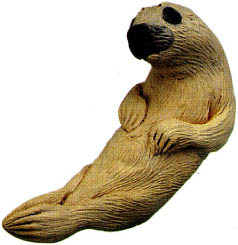
Table of Contents
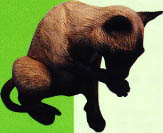
Chapter One
A Polymer Clay Primer
Chapter Two
Tools of the Trade
Chapter Three
Mastering the Basics
Chapter Four
Creating Animals Step by Step
Chapter Five
Changing the Size, Pose, Setting or Finish
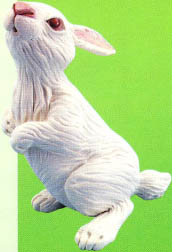
Introduction
T here is nothing more satisfying than holding a lump of clay in your hands and pushing it into a simple shape. The satisfaction becomes delight as those same shapes evolve into complex, recognizable forms. This is a sensation I discovered long ago in a clay bank on the shores of Lake Michigan.
A secret place, a wonderful place, I spent one remarkable summer digging in that bank, pounding the streaky, gray clay until it was just right for modeling. I pushed it into simple shapes and put those shapes together.
Soon rabbits and mice, squirrels and raccoons and a deer with twiggy antlers lined the bank. Too soft to touch, too soft to move, my lumpy little animals remained on the bank where they baked hard in the summer sun, then melted with the first hard rain.
A few vanished, taken by a stranger who drew funny pictures in the clay, turning his footprints into long-nosed Kilroy faces and elephant ears. Finders, keepers, he wrote. Beneath the words, underlining them, was a tiny spoon with its handle bent, the bowl beaten flat and smooth.
I set to work shaping the clay with my new tool, hoping the Kilroy man would leave more tools, that he would find my efforts worth sharing. Sometimes he did, and those were giddy moments. More often than not he left heartbreaking critiques. Once he destroyed one of my pieces utterly, replacing it with his own elegant creation, teaching me without words how to sculpt a horse.
Before summer's end I had acquired six tools, two books and a beginning knowledge of proportion. On the flyleaf of one of the books, his last gift to me, he wrote these words: Thank you for sharing the delight. J. P
Next page
